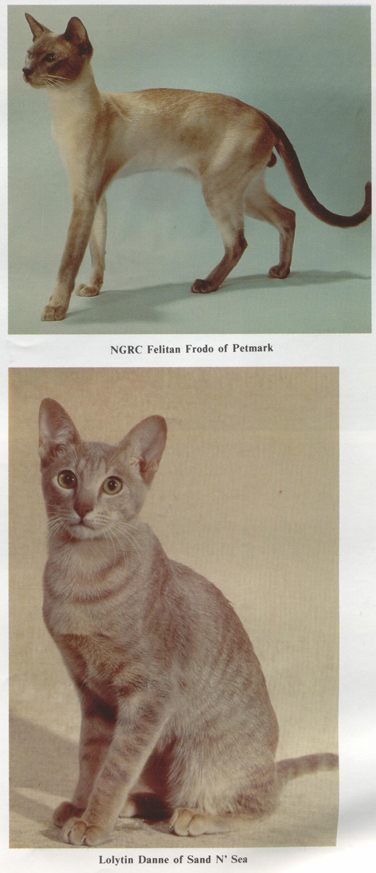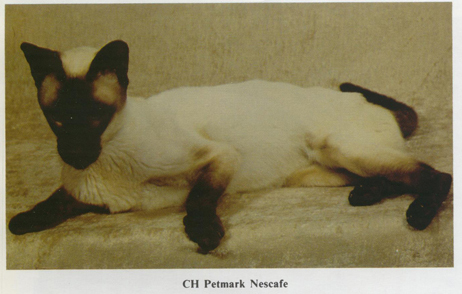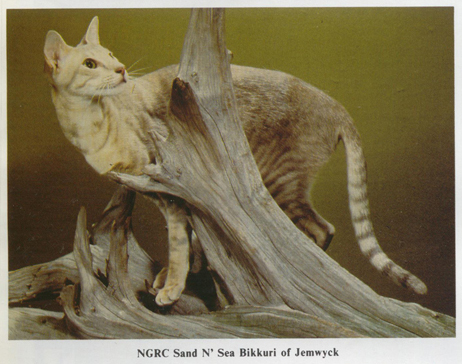|
Looking for Standard
A group of New York area cat fanciers, primarily Siamese breeders, met
informally at the Markstein’s house in the very next year to discuss
the possibility of non-pointed Siamese-type cats and to determine a
provisional standard and potential colors for this new breed. The first
official meeting of Oriental Shorthairs International (OSI) took place
on October 19, 1973. The group was articulate, intelligent, and rowdy
(rather like the cats that they were soon to breed). Some were already
successful breeders of top show Siamese. They discussed the possible
standard at length. Should it be the Siamese standard, word for word,
except for color? What should the new colors be called?
Since none of the original OSI members had Orientals at home before the
formed the standard, sentiment did not interfere with the desire for an
ideal cat, which was to be a perfect Siamese in brand new clothes. As a
result the only changes to the Siamese standard were the removal of the
word “medium” from the description of the head and the word
“dainty” from the description of the body. These breeders felt that
both the words dainty and medium interfered with the description, long.
Bill Eisenman, a charter member of OSI says that at that time there was
a tendency towards miniaturization in the Siamese classes due to
“dainty” being misinterpreted as a description of size. The Oriental
breeders felt that there was no room for ‘cuteness’ or undersized
cats in the ideal long, lean, tall and elegant cat. A fact with which
Siamese breeders concurred, as some time later the word dainty was
removed from the Siamese standard.
Color descriptions, however, are another matter. All of this idealistic
high-mindedness had some OSI members waxing poetic in their desire to
make the Oriental colors sound distinctive while other members wanted
the colors to remain consistent with CFA norms. After the dust settled
ebony, lavender and chestnut had been voted in, but ivory, apricot and
peach had lost to more sensible white, red and cream. Another big issue
was whether bicolors should be allowed. Since most of the new Oriental
breeders had been Siamese and Colorpoint breeders, they wanted to adhere
to colors acceptable in those breeds. Many of these breeders assumed
that all the Siamese type cats, Siamese, Colorpoints and Orientals,
would eventually end up to be divisions of one breed, the same that
happened with the Persian colors and Himalayans. They did not want the
white spotting factor to interfere with this. So, after much discussion,
bicolors were disallowed primarily to remain consistent with Siamese and
Colorpoint colors. Silver seemed to be an allowable exception to this
rule of thumb for colors because at that time silver was thought to be
at the same locus as the Siamese point color gene. In other words it was
thought that a cat could not be pointed and silver at the same time
(which turned out not to be true. It’s just very hard to tell if a
pointed cat is silver except by breeding it). If that had been true, a
pointed cat out of a silver cat could not have been silver so the
presence of the silver gene in the Orientals would not carry over to the
“Colorpoints” and “Siamese” out of Orientals. In fact, now that
colorpoint colors out of Orientals compete in championship in the
Colorpoint class it still doesn’t matter because silver lynx-point and
tortie smoke-point Orientals almost always look exactly like their
non-silver Colorpoint cousins in terms of color. The
standard was submitted and quickly approved. CFA accepted the Oriental
Shorthair for registration in October 1974.
Aside from the white spotting factor the Oriental breeders aim was to
allow all possible domestic cat colors while conforming very firmly to
the Siamese standard. Initially, several possible colors were left out
inadvertently, many of which have since been added. For instance, dilute
silver tabbies were not originally a listed color, blue and lavender
silver tabbies were accepted in 1984. Even now not all theoretically
possible colors have a color description and class number and even so
some of the colors listed for the breed, like lavender shaded silver,
have never yet been seen! Cinnamon and fawn (the dilute of cinnamon)
were also not in the original color list although these colors have
actually existed in the Siamese and colorpoint population for at least
several decades. Most cinnamon and cinnamon carriers have descended from
English imports where the color has been referred to as “light
chocolate” and the double-dilute chocolate. The color apparently
originated in a red Abyssinian outcross into the British Siamese in the
1960s. In the middle 1970s, the oriental breeders didn’t know that
they were getting that particular bonus.
The charter members of OSI were very aggressive, not only in their pursuit
of their ideal cat, but also popular support. OSI quickly enlisted the
breeders of lavenders. Tawnee Ballerina, one of Ann Bilheimer’s cats,
was one of the first CFA grands and other color proto-Orientals. By
February 1974 seven British Orientals had arrived. The best Siamese
belonging to OSI members were soon bred to these cats. By the time
registration was accepted there were over 60 breeders and almost 100
cats! During the next year a
great effort was made to recruit as many new breeders as possible and to
register every single Oriental kitten. This massive registration
drive, masterminded by Ann Tacetta, was undoubtedly a major factor in
the Orientals being advanced to provisional status in October, 1975.
Orientals now appeared regularly at shows where they wee very well
received, not only by judges and exhibitors, but by the general public.
The future already looked bright when, in an unprecedented move, CFA
accepted all proposed colors for championship status in October 1976,
effective May 1, 1977. Oriental Shorthairs had a running start: from an
idea contemplated in 1973, to acceptance for registration in 1974, and
to competing in championship two and a half years later. This sort of
exhilarating beginning has never occurred before and will probably not
happen again because, perhaps unfortunately, CFA no longer advances
status so quickly.
The Orientals were an immediate success. Bill Eisenman remembers the first
classes of Orientals as being beautiful, homogeneous in quality and
type, and in startling colors. Judy Hymas-Thomas, after struggling for
years to improve the type on Colorpoints, said that the Orientals were
astonishing “like Athena springing full grown from the brow of Zeus,
beautiful and mature.” How did this happen? Careful thought and
cooperation from many breeders produced these cats, it was no accident.
The single most important cat behind the early Oriental Shorthair
show-stoppers was probably NGRC Felitan Frodo* of Petmark, the most
successful so how Siamese of the ‘70s. Frodo, a blue point, was Best
Siamese and 13th Best Cat in 1972-1973. He was a cat of great
elegance and style with phenomenally long legs, sweet disposition, and
“horror of horrors” he dated tabbies and solids more often than cats
of his own race. Several other Siamese cats also had a strong impact on
the early Orientals, two of these cats CH Felitan Bilbo Baggins and a
Frodo son CH Petmark Nescafe* were much more notable as breeders than as
show cats. Both had very extreme type if not everything needed to be a
top show cat. They mixed very well with the British import Orientals and
the domestic pre-Orientals, which were generally appealing cats, but
rather moderate in type.
Not every breeder is willing to chance the breeding of wildly
different looking cats in hopes of creating the necessary balance and
beauty of a show cat, but it does work. Alison Hedberg (Sand n’ Sea
Cattery) was the kind of breeder who would, not only with her own cats,
but also to help other breeders. Siamese and Oriental breeders alike
remember Alison fondly as a person who was always willing to help a
beginner. She was always looking towards the future of her breeds and
the cat fancy as a while, as opposed to just gunning for personal
success. The results of her efforts, therefore, are everywhere and live
on in a multitude of pedigreed not just in fading memory. One of her
most notable personal achievements was the breeding that produced the
first top winning Oriental. Alison obtained a pretty little lavender
tabby, Lolytin Danae of Sand n’ Sea,* who had been bred by Lynn
Hirshfeld (Miller). Danae was out of a Frodo son, Petmark Wizard of
Lolytin, and one of the imported Orientals, Harislau Myosotis, also a
lavender tabby. Danae was a pretty, but moderate cat. With the hopes of
producing a typier Oriental, Alison bred Danae to Nescafe who was
everything but moderate or pretty. Nescafe had a head a million miles
long, with legs to match, and a face that perhaps only a mother could
love. The results were fabulous, not only a top twenty cat, but
littermates such as Sand n’ Sea Bokar of Denali, who went on to found
entire lines of Orientals. The top twenty cat was NGRC Sand n’ Sea
Bikkuri of Jemwyck,* and this is hr story as told by her owner, Jayne E.
Murray. |



* denotes cat pictured
|


